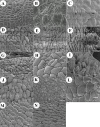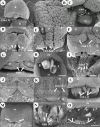Anther development in tribe Epidendreae: orchids with contrasting pollination syndromes
- PMID: 29503766
- PMCID: PMC5833465
- DOI: 10.7717/peerj.4383
Anther development in tribe Epidendreae: orchids with contrasting pollination syndromes
Abstract
Background: Epidendreae is one of the most diverse tribes among the orchids with remarkable variation in life form, floral morphology and pollination syndromes. Its circumscription was recently revised and subtribes Agrostophyllinae and Calypsoinae were transferred into this tribe. One of the principal floral characters utilized in classification of orchids is the incumbency or bending of the column. This study records and compares late stages of anther, column and lip development, and discusses anther characters in fifteen representative taxa of five of the six subtribes in Epidendreae with respect to classification and pollination biology.
Methods: A series of late floral stages were sampled and fixed for examination under scanning electron microscope.
Results: Anther incumbency or bending in this group varies from 90° to almost 180°. Incumbency in the late stages of development is reached in Bletiinae, Ponerinae, Pleurothallidinae and Laeliinae whereas incumbency is reached early in its development in Corallorhiza and Govenia of Calypsoinae.
Discussion: Our observations indicate that the position of Chysis in subtribe Bletiinae needs revision based on differences in a number floral, and in particular of anther characters; and that Coelia only shares the early anther incumbency with Calypsoinae members, but not the rest of floral and anther characters. Anatomical characters such as crystals around the actinocytic stomata on the anther cap and sugar crystals in Laeliinae; lack of rostellum in Bletiinae; coalescent anther with the column, lack of trichomes and papillae on lip keels, and underdeveloped rostellum in Chysis; a mechanism by which the anther cap comes off (it is joined with the grooved lip by a claw) in Isochilus are all related to pollination syndromes and reproductive biology.
Keywords: Anther; Chysis; Development; Epidendreae; Incumbency; Orchidaceae; Pollination.
Conflict of interest statement
Victoria Sosa is an Academic Editor for PeerJ.
Figures






Similar articles
-
An overview of the phylogenetic relationships within Epidendroideae inferred from multiple DNA regions and recircumscription of Epidendreae and Arethuseae (Orchidaceae).Am J Bot. 2005 Apr;92(4):613-24. doi: 10.3732/ajb.92.4.613. Am J Bot. 2005. PMID: 21652439
-
The evolution of anther morphology in orchids: incumbent anthers, superposed pollinia, and the vandoid complex.Am J Bot. 2002 Nov;89(11):1747-55. doi: 10.3732/ajb.89.11.1747. Am J Bot. 2002. PMID: 21665601
-
Morphology of floral papillae in Maxillaria Ruiz & Pav. (Orchidaceae).Ann Bot. 2004 Jan;93(1):75-86. doi: 10.1093/aob/mch007. Epub 2003 Nov 20. Ann Bot. 2004. PMID: 14630691 Free PMC article.
-
Floral isolation, specialized pollination, and pollinator behavior in orchids.Annu Rev Entomol. 2009;54:425-46. doi: 10.1146/annurev.ento.54.110807.090603. Annu Rev Entomol. 2009. PMID: 19067636 Review.
-
On the success of a swindle: pollination by deception in orchids.Naturwissenschaften. 2005 Jun;92(6):255-64. doi: 10.1007/s00114-005-0636-y. Naturwissenschaften. 2005. PMID: 15931514 Review.
References
-
- Arditti J. Fundamentals of orchid biology. John Wiley & Sons; New York: 1992.
-
- Borba EL, Braga PIS. Biologia reprodutiva de Pseudolaelia corcovadensis (Orchidaceae): melitofilia e autocompatibilidade em uma Laeliinae basal. Revista Brasileira de Botânica. 2003;26:541–549. doi: 10.1590/S0100-84042003000400013. - DOI
-
- Chase MW, Cameron KM, Barrett RL, Freudenstein JV. DNA data and Orchidaceae systematics: a new phylogenetic classification. In: Dixon KW, Kell SP, Barret RL, Cribb PJ, editors. Orchid conservation. Natural History Publications; Kota Kinabalu, Sabah: 2003.
-
- Chase MW, Cameron KM, Freudenstein JV, Pridgeon AM, Salazar GA, Van den Berg C, Schuiteman A. An updated classification of Orchidaceae. Botanical Journal of the Linnean Society. 2015;177:151–174. doi: 10.1111/boj.12234. - DOI
LinkOut - more resources
Full Text Sources
Other Literature Sources
Miscellaneous

